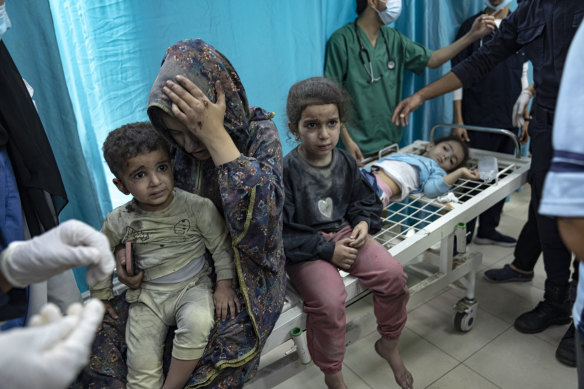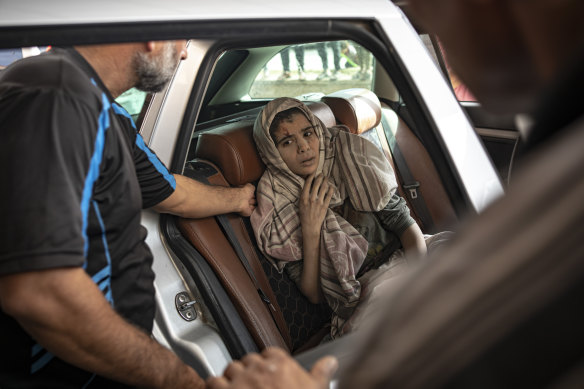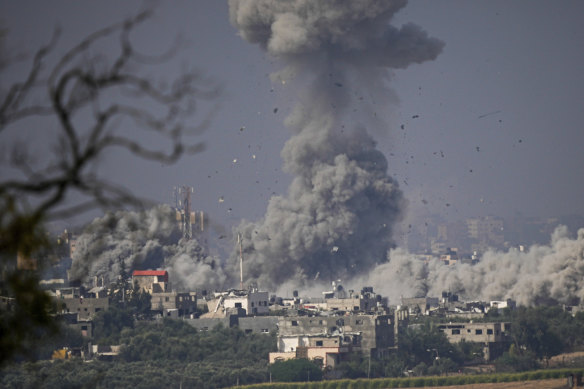This was published 1 year ago
‘They are outside’: Heavy fighting rages near main Gaza hospital, people trapped inside
By Wafaas Shurafa and Samy Magdy
Khan Younis: Health officials and people trapped inside Gaza’s largest hospital rejected Israel’s claims that it was helping babies and others evacuate on Sunday, saying fighting continued just outside the facility where incubators lay idle with no electricity and critical supplies were running out.
Prime Minister Benjamin Netanyahu has spurned urgent international calls for a ceasefire unless it includes the release of all the nearly 240 hostages captured by Hamas in the October 7 rampage that triggered the war.
The US carried out two airstrikes in Syria against Iran-aligned groups on Sunday, the US said.

Palestinians wounded in Israeli bombardment of the Gaza Strip are brought to a hospital in Khan Younis.Credit: AP
A day after Netanyahu said Israel was bringing its “full force” with the aim of ending Hamas’ 16-year rule in Gaza, residents reported heavy airstrikes and shelling, including around Al Shifa Hospital. Israel has accused Hamas of concealing a command post inside and under the compound, allegations denied by Hamas and hospital staff.
“They are outside, not far from the gates,” said Ahmed al-Boursh, a resident sheltering at the facility.
The hospital’s last generator ran out of fuel on Saturday, leading to the deaths of three premature babies and four other patients, according to the Health Ministry. It said another 36 babies are at risk of dying without electricity.

A Palestinian wounded in Israeli bombardment of the Gaza Strip is brought to a hospital in Khan Younis.Credit: AP
Israel’s military asserted it placed 300 litres of fuel near Al Shifa overnight and co-ordinated the delivery with hospital officials. But the delivery location was not clear from the military’s video, and there was no immediate response from the Health Ministry and others including the Red Cross.
Health Ministry undersecretary Munir al-Boursh said Israeli snipers had deployed around the hospital, firing at any movement inside the compound. He said airstrikes had destroyed several homes next to the hospital, killing three people, including a doctor.
“There are wounded in the house, and we can’t reach them,” he told Al Jazeera television. “We can’t stick our heads out of the window.”
Speaking to CNN, Netanyahu asserted that “100 or so” people had been evacuated from the hospital and that Israel had created safe corridors.
But the Health Ministry has denied claims of evacuees and safe corridors, and people sheltering in the hospital said they were afraid to go outside.
The military said troops would assist in moving babies on Sunday, and that it was in contact with Al Shifa staff.
But Medical Aid for Palestinians, a UK-based charity that has supported the hospital’s neonatal intensive care unit for years, questioned the military’s assertion. “The transfer of critically ill neonates is a complex and technical process,” CEO Melanie Ward said in a statement. “With ambulances unable to reach the hospital ... and no hospital with capacity to receive them, there is no indication of how this can be done safely.”
The only safe option is for Israel to stop its assault and allow fuel to reach the hospital, she said.
The Health Ministry said there are still 1500 patients at the hospital, along with 1500 medical personnel and between 15,000 and 20,000 people seeking shelter.
The Palestinian Red Crescent rescue service said another Gaza City hospital, the Red Crescent-run Al-Quds, is “no longer operational” because it has run out of fuel. Gaza’s sole power plant was forced to shut down a month ago, and Israel has barred any fuel imports, saying Hamas would use them for military purposes.
Nebal Farsakh, a Red Crescent spokesperson, said 6000 people, including displaced families, patients, and staff, remained trapped in the hospital.
Alarm was growing. “Decisive international action is needed now to secure an immediate humanitarian ceasefire and prevent further loss of life” amid attacks on health care, the UN regional directors of the World Health Organisation and others said in a statement, adding that more than half of Gaza’s hospitals were closed and the rest were under “massive strain.”
“We do not want to see a firefight in a hospital where innocent people, helpless people, people seeking medical care are caught in the crossfire,” President Joe Biden’s national security adviser, Jake Sullivan, told ABC’s This Week.
Muhammed Zaqout, director of hospitals in Gaza, said the Health Ministry had been unable to update the death toll since Friday as medics couldn’t reach areas hit by Israeli bombardment. “The situation is extremely dire,” he said. “Ambulances are unable to reach people under the rubble.”
About 2.3 million Palestinians remain trapped in the besieged territory.
Netanyahu has said the responsibility for any harm to civilians lies with Hamas. Israel has long accused the group, which operates in dense residential neighbourhoods, of using civilians as human shields.

Smoke rises from an explosion following an Israeli airstrike in the Gaza Strip, as seen from southern Israel.Credit: AP
Jordanian Foreign Minister Ayman Safadi said Sunday on X, formerly Twitter, that he asked European Union foreign policy chief Josep Borrell to apply the same “legal, moral grounds” for EU support of Ukraine to “define its stand on Israel’s war crimes.”
The US has pushed for temporary pauses that would allow for wider distribution of badly needed aid to civilians in the besieged territory, where conditions are increasingly dire.
But Israel has only agreed to brief daily periods during which civilians can flee the area of ground combat in northern Gaza and head south on foot along two main roads. Israel continues to strike what it says are militant targets across southern Gaza, often killing women and children.
Dozens of wounded people, including children, were brought to a hospital in Khan Younis after an Israeli airstrike demolished a building in the southern town. Hospital officials said at least 13 were killed.
The war has displaced over two-thirds of Gaza’s population, with most fleeing south. Egypt has allowed hundreds of foreign passport holders and medical patients to exit through its Rafah crossing, as well as the entry of a small amount of humanitarian aid.
More than 11,000 Palestinians, two-thirds of them women and minors, have been killed since the war began, according to the Health Ministry in Gaza, which does not differentiate between civilian and militant deaths. About 2700 people have been reported missing and are thought to be trapped or dead under the rubble.
At least 1200 people have been killed on the Israeli side, mostly civilians killed in the initial Hamas attack. (Israel lowered its death toll from 1400 on Friday.)
Forty-six Israeli soldiers have been killed in Gaza since the ground offensive began.
About 250,000 Israelis have been forced to evacuate from communities near Gaza, where Palestinian militants are still firing barrages of rockets, and along the northern border with Lebanon.
The war threatens to trigger a wider conflict, with Israel and Hezbollah militants in Lebanon frequently trading fire along the border.
Hezbollah fired anti-tank missiles into Israel on Sunday, and Israel responded with artillery and fighter jets.
The United States carried out two air strikes in Syria against Iran-aligned groups on Sunday, a US defence official told Reuters, in what appeared to be the latest response to a series of attacks against American forces in Syria and in Iraq.
The official, who spoke on condition of anonymity, said one of the targets was a weapons storage facility. The other was a “command and control” facility, which would suggest a headquarters or other staffed structure.
The official said the strikes took place within the past couple of hours and said a US review was underway to determine whether the strikes killed or wounded any Iran-aligned militia members.
Tens of thousands of people marched in Paris on Sunday to protest against rising antisemitism.
AP, Reuters
More coverage of the Hamas-Israel conflict
- Cascading violence: Tremors from the Hamas attacks and Israel’s response have reached far beyond the border. But what would all-out war in the Middle East look like?
- The human cost: Hamas’ massacre in Israel has traumatised - and hardened - survivors. And in Gaza, neighbourhoods have become ghost cities.
- “Hamas metro”: Inside the labyrinthine network of underground tunnels, which the Palestinian militant group has commanded beneath war-ravaged Gaza for 16 years. The covert corridors have long provided essential channels for the movement of weapons and armed combatants.
- What is Hezbollah?: As fears of the conflict expanding beyond Israel and Hamas steadily rise, all eyes are on the militant group and political party that controls southern Lebanon and has been designated internationally as a terrorist group. How did it form and what does Iran have to do with it?
Get a note directly from our foreign correspondents on what’s making headlines around the world. Sign up for the weekly What in the World newsletter here.